|
National Archaeological Museum of Athens: Gods In Color
On January 29, 2007, a new Exhibition was opened to the public at the National Archaeological Museum in Athens. After having made the rounds at a variety of Museums in Europe, “Gods in Color” has been on view in Athens until March 25th. However, thanks to our Album, visitors to our website will be enjoying it permanently! The 21 casts exhibited (in Ground floor Galleries 44 and 45) are of well-known statues (Cuirassed torso of the statue of an archer or chariot driver from the Acropolis Museum, Akr 599, the bronze head of a victor from Glyptothek München, the “Peplos Kore” from the Acropolis of Athens Museum, Akr. 679, the Lion of Loutraki, etc), of Tombstone Stelae (tombstone of Aristion, the one of Paramythion, etc), of Pediment sculptures (from the Athena Afaea Temple in Aegina, the East Frieze of the Siphnian Treasury in Delphi, parts of the so called Sarcophagus of Alexander the Great) and specimens of real pigment used in antiquity. (Text and Photos: Michael Tziotis)
Select Page of the Album:
Click on any of the pictures to enlarge.
Colored Casts of StatuesThe discovery, back in the 1880's, of the archaic statues on the Acropolis of Athens, apart from its scientific significance, created an astonishing feeling: the figures were painted in color. Traces of their polychrome decoration were still visible. The majority of the newly found artefacts were marble statues of maidens, the so-called Korai, whose garments were ornamented with polychrome designs.
The casts of the statues made in the 18th and the 19th centuries were not painted. After the discovery of the Acropolis' statues, however, attempts were made to reproduce the plaster replicas according to the originals. Casts in color were thus produced, including the two casts of the Acropolis Kore no. 674, which are exhibited here.
Among the first to be impressed by the polychromy of ancient sculpture, and who attempted to reproduce it, either in drawings and aquarelles or in casts, were the Swiss Louis Emile Gilliéron (1851-1924) and his son, who were active in Greece at the end of the 19th and the beginning of the 20th century.
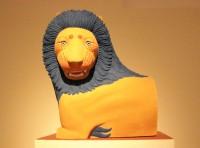
The Lion from Loutraki
The lion was, most probably, set up ca. 550 B.C. as a guard of a tomb. The original is exhibited today in Copenhagen, together with a second similar grave lion. In Antiquity it was placed in such a height, so that the gaping jaws would have been visible as one approached.
The reconstruction of the paintwork proceeds from surviving traces on the original and its companion, as well as evidence from other sculptures-Red paint is present on the tongue and the lips; there are also traces of blue on the mane and yellowish-brown ochre on the lion's skin.
A lion with a blue mane in early Greek sculpture is not uncommon: A water-spout from a building on the Acropolis in Athens is shown here (Photo below) |
|
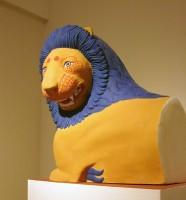
The Lion from Loutraki
Research and interpretation of the original: Vinzenz Brinkmann
Production and completion of the cast: Workshop of NY Karlsberg Glyptotek, Kopenhagen
Painting using authentic pigments and binders: Ulrike Koch-Brinkmann
Blue: Azurite
Red: Natural Cinnabar
Green: Malachite
Yellow: Ochre
Cast: Stiftung Archäologie
Original: NY Karlsberg Glyptotek, Kopenhagen
The pores and the wrinkles on the nozzle were most probably depicted in red colour and are preserved now as shadows. |
|
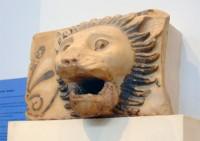
Akr 69. Lion Head Waterspout
Marble lion head waterspout from the “sime” of the old Temple of Athena, just south of the Erechtheion. The lion head, its savage expression strikingly rendered, is vividly painted on the mane, jaws and eyes and framed by a painted palmette. Fragments of a second lion head and two ram heads from the four corners of the temple “sime” are preserved. Last quarter of 6th century B.C. |
|
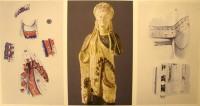
Informative photo compilation on the kore Akr. 674 (Acropolis Museum) coloring research. |
|
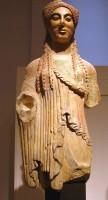
Painted plaster cast of the kore Acr. 674 from the Acropolis Museum.
According to the stamped signature on the base, it was manufactured by Ingrid Kjaer in 1901. The colors used are after an older aquarelle by Louis Emile Gilléron. |
|
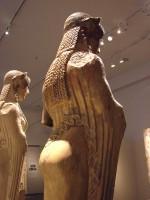
Same painted plaster cast of the kore Acr. 674 photographed from the back.
To the left, another painted cast of the same statue, yet with limited use of colors |
|
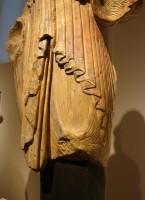
Kore Acr. 674: Details of her clothing at the front |
|
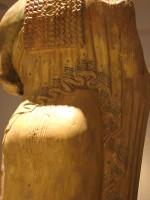
Kore Acr. 674: Details of her clothing and hair at the back |
|
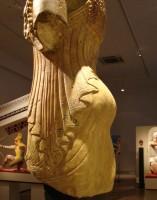
Kore Acr. 674: Yet another photo of the heavily colored cast |
|
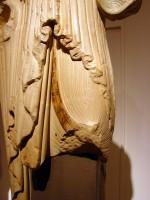
Painted plaster cast of the kore Akr. 674 from the Acropolis Museum with limited use of colors.
The limited use of colors and the simplified ornament clearly show that the restaurator did not have access to the colored reconstruction of Louis Emile Gilléron, shown in the previous photos. The plaster cast can be dated to the beginning of the 20th century, after the missing edge of the himation hanging from below the right elbow was completed. |
|
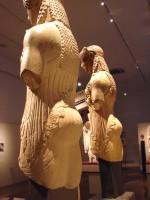
Painted plaster cast of the kore Akr. 674 from the Acropolis Museum with limited use of colors.
The clothing is strikingly less ornamented and colored than on the first cast (shown on the right). |
|
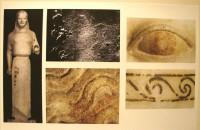
Gods in Color: Informative Photo on the Athenian Acropolis “Peplos Kore” (inv. nr. Akr 679) Coloring Research
One of the most beautiful Korai is the «Peplos Kore» from 530-520 B.C. Traces of red, blue, green and yellow paint have been preserved on the hair, the eyes, the belt, the garment's hem and on the patterns in the fabric. In ultraviolet light and under strong raking light details, not previously imagined, become visible.
These reveal that the garment is, possibly, not a peplos at all. Under a shoulder cape she is wearing a long gown girdled with a belt. The gown opens where it is belted and we are given a glimpse of the dress underneath with circumferential friezes filled with figures which were incised before being painted. Her innermost garment is a chiton reaching to her feet. This is the attire of a goddess, and what we are looking at is, in fact, not a kore but a goddess: possibly Artemis or Athena, as both were worshipped on the Acropolis. The second reconstruction shows Artemis with bow and crown. |
|

A cast of the Athenian Acropolis “Peplos Kore” shown as goddess Artemis
Examination and interpretation: Vinzenz Brinkmann
Restoration οf breaks: Alfons Neubauer, Cristiph Bergmann
Gilding: : Sylvia Kellner
Painting: Ulrike Koch-Brinkmann
Authentic natural pigments applied in tempera-technique:
Blue: Azurite, Green: Malachite, Red: Natural Cinnabar, Brown, Yellow: Ochre
Painted casts: Staatliche Antikensammlungen und Glyptothek, Stiftung Archäologie
Original: Athens, Acropolis Museum, inv. nr. 679 |
|
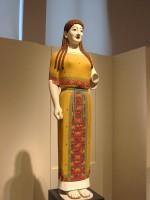
A cast of the Athenian Acropolis “Peplos Kore” shown as goddess Athena
Examination and interpretation: Vinzenz Brinkmann
Restoration οf breaks: Alfons Neubauer, Cristiph Bergmann
Gilding: : Sylvia Kellner
Painting: Ulrike Koch-Brinkmann
Authentic natural pigments applied in tempera-technique:
Blue: Azurite, Green: Malachite, Red: Natural Cinnabar, Brown, Yellow: Ochre
Painted casts: Staatliche Antikensammlungen und Glyptothek, Stiftung Archäologie
Original: Athens, Acropolis Museum, inv. nr. 679 |
|
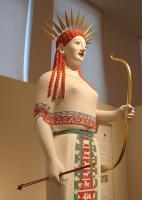
Another photo of the cast of the Athenian Acropolis “Peplos Kore” shown as goddess Artemis |
|
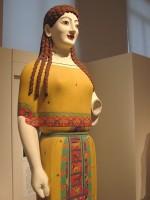
Another photo of the cast of the Athenian Acropolis “Peplos Kore” shown as goddess Athena |
|
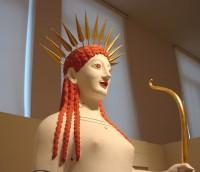
Photo of the bust of the cast of the Athenian Acropolis “Peplos Kore” shown as goddess Artemis |
|
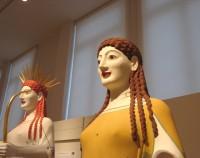
Photo of the bust of the cast of the Athenian Acropolis “Peplos Kore” shown as goddess Athena
The cast reconstructed to show goddess Artemis is also visible |
|
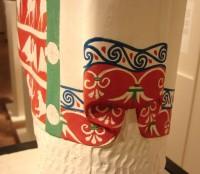
Cast of the Athenian Acropolis “Peplos Kore” shown as goddess Artemis
Detail of the dress coloring |
|
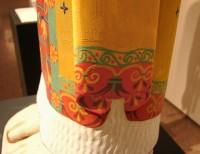
Cast of the Athenian Acropolis “Peplos Kore” shown as goddess Athena
Detail of the dress coloring |
|
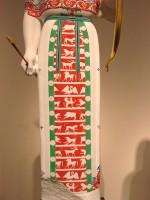
Cast of the Athenian Acropolis “Peplos Kore” shown as goddess Artemis
Dress coloring (front) |
|
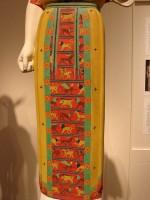
Cast of the Athenian Acropolis “Peplos Kore” shown as goddess Athena
Dress coloring (front) |
|
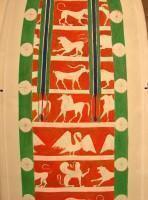
Cast of the Athenian Acropolis “Peplos Kore” shown as goddess Artemis
Dress coloring detail (front) |
|
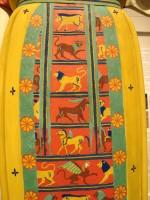
Cast of the Athenian Acropolis “Peplos Kore” shown as goddess Athena
Detail of the dress coloring front |
|
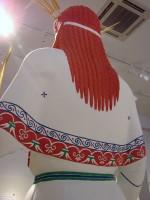
Photo of the back and hair of the cast of the Athenian Acropolis “Peplos Kore” shown as goddess Artemis |
|
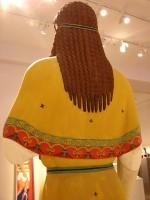
Photo of the back and hair of the cast of the Athenian Acropolis “Peplos Kore” shown as goddess Athena |
|
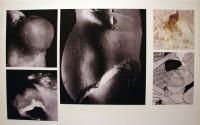
Akr 599. Cuirassed torso from the Athenian Acropolis (Informative photo compilation)
This torso comes from the statue of an archer or chariot driver set up around 470/60 B.C. in the Sanctuary of Athena on the Acropolis. The muscles have been rendered with the taut naturalism characteristic of the Early Classical "Severe Style" The sculptures on the Temple of Zeus at Olympia are close parallels.
In Antiquity a metal cuirass was modelled on the musculature. The sculptor therefore just carved the lower edge of the armor. The rest of the body would have appeared naked had it not been for the sculpture painter. The armor was painted on, as was the clothing underneath. Ultraviolet and raking light reveal a short chiton, whose pattern of leaves was incised before painting began. Warriors with such thin transparent costume can be seen in contemporary vase painting. The garments are often left open so that the genitals are visible.
No traces of paint have been preserved. We have only the weathering relief and the UV photographs to work with. But we do know that the colors became more "delicate" in the Classical Period, mixed with white; and that yellow ochre was used to represent bronze.
The second reconstruction shows an alternative reconstruction with a more limited color scheme and a gilded cuirass. |
|
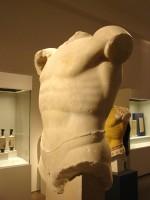
Akr 599. Cuirassed torso from the Athenian Acropolis
White marble. About 470 B.C The piece depicts most probably an archer. Below the corslet he wears a closefitting chitoniskos, on which traces of a painted floral decoration survive. |
|
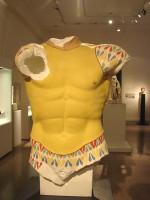
Painted Cast of Cuirassed torso from the Athenian Acropolis (Akr 599); the first coloring hypothesis.
Examination of original, documentation and interpretation: Vinzenz Brinkmann.
Making of plaster copy: The Acropolis Museum workshop
Gliding: Sylvia Kellner
Painting (using authentic pigments and binder): Ulrike Koch-Brinkmann
Blue = Egyptian Blue
Red = Cinnabar
Green = Malachite
Yellow = Ochre
Skin color = Madder, Ochre, Chalk
Painted casts: Staatliche Antikensammlungen und Glyptothek, Stiftung Archäologie
Original: Athens, Acropolis Museum, Akr. 599 |
|
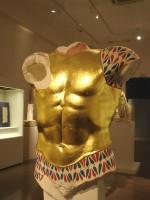
Painted Cast of Cuirassed torso from the Athenian Acropolis (Akr 599). The second of the two different coloring hypotheses.
Examination of original, documentation and interpretation: Vinzenz Brinkmann.
Making of plaster copy: The Acropolis Museum workshop
Gliding: Sylvia Kellner
Painting (using authentic pigments and binder): Ulrike Koch-Brinkmann
Blue = Egyptian Blue
Red = Cinnabar
Green = Malachite
Yellow = Ochre
Skin color = Madder, Ochre, Chalk
Painted casts: Staatliche Antikensammlungen und Glyptothek, Stiftung Archäologie
Original: Athens, Acropolis Museum, Akr. 599
|
|
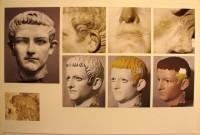
Portrait of Caligula (Informative collection of photos)
The original portrait of the Emperor Gaius Julius Augustus Germanicus, called Caligula (37-41 AD.), bears traces of paint, which have been analysed:
Between the lips and along the eyelids lake of madder has been used lightened with white. The pigment is obtained from the roots of the madder plant. Under the left ear the skin color has been preserved: this is a mixture of ochre and chalk with egg as binder. The hair, the eyelashes and the pupils all have traces of "boneblack", made from carbonised bones. The black paint was only used as an ‘underpainting’. It is visible through the skin color.
The black paint produces deeper shadows in the hair. The hair color has not been preserved; it seems that it was dark brown. There is indirect evidence for the use of golden ochre as underpaint. This gives depth to the hair color and facilitates a natural transition from the hair to the skin.
The application of the paint in succesive layers has resulted to a final shadowing effect. |
|
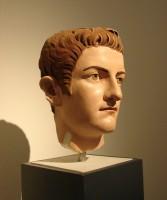
Portrait of Caligula: Colored Cast
Pigment analyses: Heike Stege, Irene Fiedler, Ursula Baumer, Doerner lnstitut, Munich
Digital marble copy:Conservation Centre Liverpool. National Museums on Merseyside
Painting (using authentic pigments and binder): Ulrike Koch-Brinkmann
White = Lead White
Brown = Ochre
Skin color = Madder, Ochre, Chalk
Black = Burned Bone
Painted cast: Stiftung Archäologie
Original: Ny Carlsberg Glyptotek, Kopenhagen |
|
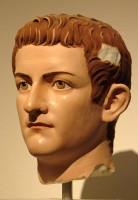
Portrait of Caligula: Colored Cast |
|
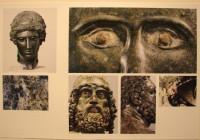
Bronze Head of a Victor: Informative collection of photos on the relevant research |
|
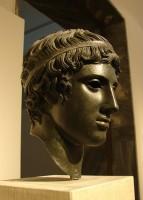
Bronze Head of a Victor: Attempt of Reconstruction |
|
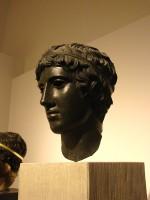
Bronze Head of a Victor: Attempt of Reconstruction |
|
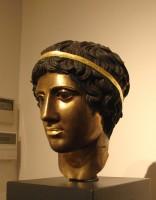
Bronze Head of a Victor: Attempt of Reconstruction
The original bronze head (ca. 20 AD.), as can be taken from engravings and descriptions, originally was furnished with colored eyes made of semiprecious stones and silver. The hair band, lips and eye brows still preserve remains of gilding. In fact, similar kinds of this 'colorful' treatment such as by inlays of colorful or precious metals were not uncommon in ancient times.
The Greeks tried to avoid the natural patina on the objects by covering it with a lacquer of asphalt and treating it regularly. However, already in Roman times most of the Greek bronzes should have had a dark patina. Even an artificial patination was known, for instance by means of sulfur. |
|
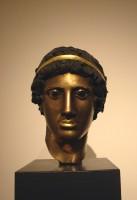
Bronze Head of a Victor: Attempt of Reconstruction
At the reconstruction on display only the eyes and the gilding might be certain. However, the red-brown coloring of the flesh and the black of the hair are possible, through hypothetical solutions. It is possible that about 70 % of all ancient sculptures were made of metal. Their polychromy may have been limited to certain areas, as in the example.
Examination:
Hagen Schaaf, Raimund Wünsche
Reconstruction: Olaf Herzog
Copy & Original: Staatliche Antikensammlungen und Glyptothek |
|
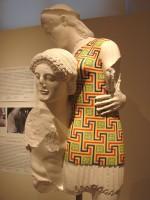
Gods in Color: Theseus Raping Antiope, Temple of Apollo-Daphnephoros, Eretria
Originally, the marble sculptures of the west pediment of the temple of Apollo-Daphnephoros in Eretria, showing combating, dying or abducted Amazons, were painted with strong natural pigments. Indeed, there are no traces of colors remaining at the kneeling Amazon with bow and arrow which was brought to Rome already in ancient times and is now exhibited in the Capitoline Museums. However, there are obvious traces of the original painting, on the other fragments that were left in Greece. By using UV-and raking light marks of the weathering of the original pattern can be made out.
The marble surface of the sculpture of Antiope, who is depicted being abducted by Theseus, has a weathering that allows the recognition the pattern which was originally painted on the collar of linen worn by her. Obviously the whole collar was adorned with swastika-meanders in a diagonal order. The free squares in between were filled with Macedonian stars. Since, in fact, no pigments of the coloring itself were found on the sculpture the choice of colors for the reconstruction on a plaster cast cannot be totally free of doubt. The relief of the weathering of the surface clearly shows the position and size of the individual elements. |
|
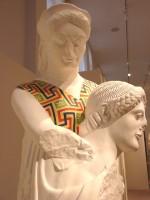
Gods in Color: Theseus Raping Antiope, Temple of Apollo-Daphnephoros, Eretria
The reconstruction shown in this and the previous photo only represents a part of the whole coloring of the composition of the pediment. All other elements of the garments were colored as well. For sure, Antiope's legs did not stay naked either. Most probably she would wear a kind of tights.
Research and interpretation of the original: Vinzenz Brinkmann
Painting (using authentic pigments and binder): Ulrike Koch-Brinkmann
Plaster cast: H. Scharpf
Blue = Azurite
Red = Cinnabar
Green == Malachite
Yellow = Ochre
Painted cast: Stiftung Archäologie
Original: Eretria, Greece. Archaeological Museum |
|
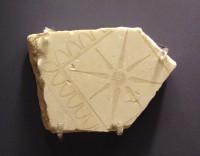
A 747. Corner-slab fragment of a coffer decorating the ceiling of the temple of Athena at Sounion. White marble. About 450 B.C.
Preserved is a part of the painted decoration. In the central square, encased in a larger one, two of the originally eight rays of a star or a sun are discerned. The triangles between the squares are decorated with a floral pattern. Outside the squares is a decorative ribbon with shallow holes, indicating the use of compasses. |
|
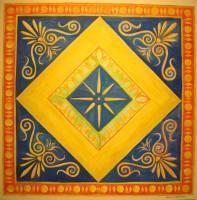
Proposal of color reconstruction of the slab of a coffer (no. A747) |
|
Select Page of the Album:
|
|
|
|



